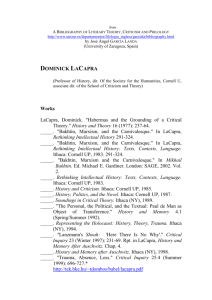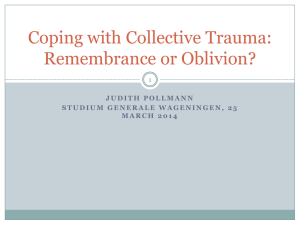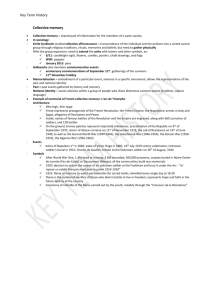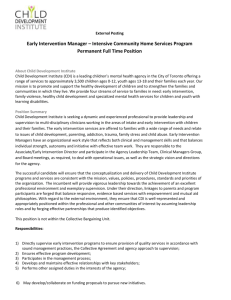Extract
advertisement
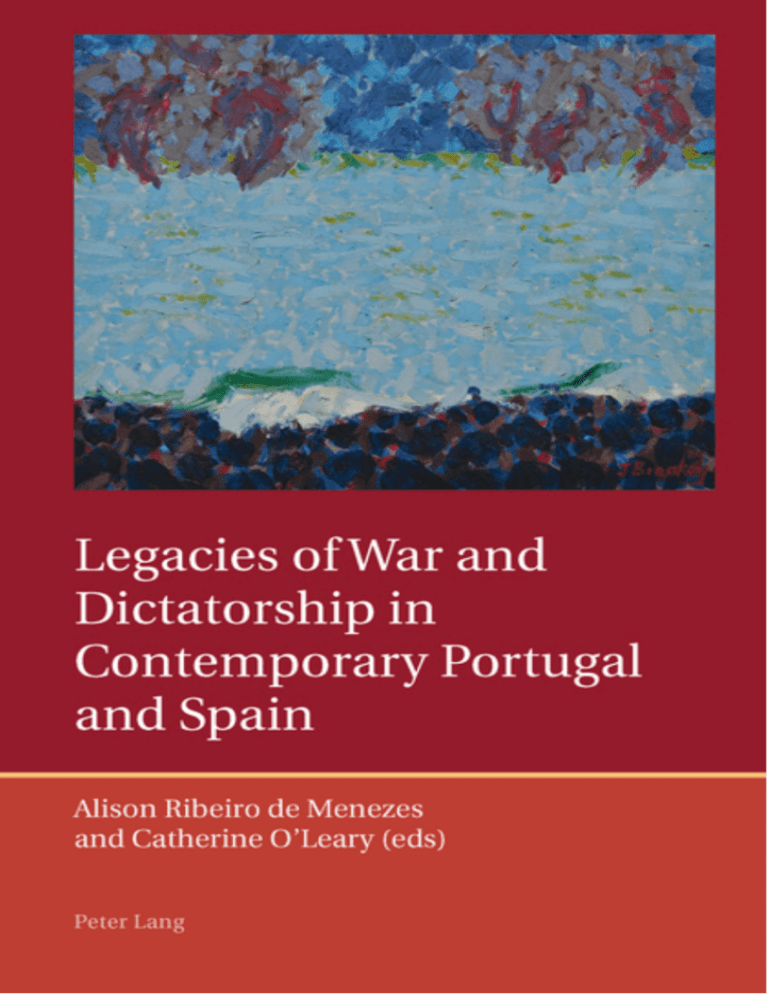
Alison Ribeiro de Menezes Introduction: Cultural Memory and the Legacies of War and Dictatorship in Contemporary Portugal and Spain Cultural Memory and Its Debates Most surveys of theoretical and scientific ref lection on cultural memory today point to three key figures: French sociologist, Maurice Halbwachs; German Egpytologist, Jan Assmann; and French historian Pierre Nora. Halbwachs, as sociologist Jef frey Olick notes, built on Emile Durkheim’s concept of the conscience collective by demonstrating the manner in which collective representations of the past circulate as the shared symbols of collective cultural inheritance.1 His work, nevertheless, has limitations: whilst his focus on memory as collective and socially constructed is immensely important in relocating memories of the past in a specific temporal and spatial context, the question of the transmission of collective memories is inadequately addressed, and hence, the problem of what happens when collective memory is stalled or impeded by political events, by authoritarian repression, or by deliberate ideological manipulation, is left unanswered. On the other hand, as Paul Connerton notes, Halbwachs stressed the importance of the relative stability of our material milieu for the creation of the illusion of the co-existence of the past in the present,2 a point of contrast 1 2 Jef frey Olick, The Politics of Regret: On Collective Memory and Historical Responsibility (New York: Routledge, 2007), pp. 5–6. Paul Connerton, How Societies Remember (Cambridge: Cambridge University Press, 1989), p. 37. 2 Alison Ribeiro de Menezes that usefully highlights the rapidity of change that not only characterizes our contemporary world but has also brought about significant changes in our relationship to the past and the manner in which we access it. The work of Jan Assmann likewise serves today to indicate the rapidly changing role of memory in contemporary society. Assmann developed Halb­ wachs’ work in distinguishing cultural memory from collective memory. The latter, he argued, has a limited life-span of three or four generations, and is informal and frequently oral; the former is more enduring, having a fixed point or horizon which does not change with the passage of time, although our interpretations of it may change. It is, he argued, made up of ‘fateful events […] whose memory is maintained through cultural formation (texts, rites, monuments) and institutional communication (recitation, practice, observance)’ which then become ‘islands of time’.3 Assmann’s emphasis on shared practice, on a common archive of memories (whether physical or symbolic, whether in a repository of books and papers or customs and practices), now seems too static, suggesting only slow changes in the memory horizon. Also problematic, in the final instance, is the work of Pierre Nora, which, echoing Halbwachs’ interest in social milieux, focuses on place and its relation to memory, which is explicitly contrasted with History (with a capital ‘H’) seen as big events and great names. For Nora, our recall of the past is a dialectic of remembering and forgetting, or a process of deformation and manipulation according to the demands of the present.4 But there is something positive, even celebratory, about Nora’s view of memory,5 just as there is something secure and enduring about Assmann’s notion of the archive, that leaves both these approaches rather unsatisfactory when it comes to a study of silenced, persecuted, or repressed collective and cultural memories. The question of troubling and traumatic memories is broached by Dominick LaCapra with regard to contemporary historiography of the Holocaust. He begins his study, Representing the Holocaust, with an epigraph 3 4 5 Jan Assmann, ‘Collective Memory and Cultural Identity’, New German Critique, 65 (1995), 125–33 (p. 129). See Pierre Nora, Les Lieux de mémoire, 3 vols (Paris: Gallimard, 1997). Olick also critiques Nora’s work from this perspective in The Politics of Regret, p. 182. Legacies of War and Dictatorship in Contemporary Portugal and Spain 3 from Freud’s well-known essay, ‘Mourning and Melancholia’, and combines it with one from Geof frey Hartman stressing the need for ‘the limits of representation to be healing limits’.6 LaCapra’s emphasis is not just on the negative elements of traumatic memory, but on the potentially positive aspects to be gained from working through such memories. LaCapra seeks to combat any tendency to become fixated on, or over-valorize, states of intense melancholia and self-victimization, whilst preserving a recognition of the existence of severe trauma and the near-impossibility of overcoming extreme suf fering. LaCapra further stresses the importance of transference as part of the interpretative process. His nuanced discussion of continuity and change in relation to the return or repetition of a repressed past, and his stress on the need to contextualize in order to uncover similarities and dif ferences in the object of study, is highly instructive.7 In discussing the complex, and far from binary, relations which he sees between Freud’s notions of melancholy and mourning, LaCapra articulates two key questions for public memory: First, does modern society have suitable public rituals that would help one to come to terms with melancholia and engage in possibly regenerative processes of mourning, even if in extremely traumatic cases an idealized notion of full recovery may be misleading? Second, who is it that one mourns and how can one specify the object of mourning in ways that are both ethicopolitically desirable and ef fective in reducing anxiety to tolerable limits?8 This seems to shift the emphasis from a separation of the public and the private, and from any binary division of the of ficially sanctioned and the repressed, towards a consideration, first, of the dialectical relationship between personal and social aspects of any ‘working-through’ of a traumatic past, leading to healing, and, second, of the need to evaluate, in a historically contextualized manner, deserving objects of mourning. 6 7 8 Dominick LaCapra, Representing the Holocaust: History, Theory, Trauma (Ithaca: Cornell University Press, 1994), p. vii. See particularly the final chapter of Representing the Holocaust, entitled ‘The Return of the Historically Repressed’. LaCapra, Representing the Holocaust, pp. 213–14. 4 Alison Ribeiro de Menezes There are, nevertheless, problems with an approach to memory that links remembering and forgetting with trauma theory, problems that are, indeed, specifically discussed by LaCapra himself.9 His stress on the need for a self-ref lexive discourse on the past that avoids the dangers of melancholia and a sublimation of trauma, which he neatly characterizes as ‘a scene fixed in amber’,10 and the centrality of what he calls ‘empathic unsettlement’, or an af fective response to a narrative of trauma, are, for Ofelia Ferrán, key aspects of his analysis of cultural memory work.11 Whilst Ferrán’s readings of specific Spanish narratives that engage in memory work demonstrate the potential of LaCapra’s approach, he himself does not of fer as illustration specific case studies, either in Representing the Holocaust or in his later volume, Writing History, Writing Trauma.12 Indeed, his preoccupation with deconstructionist thought and its emphasis on binary oppositions, whilst perhaps understandable at the time of writing, has a dated ring in the context of, on the one hand, Marianne Hirsch’s development of the notion of ‘postmemory’ – which takes the question of emotional engagement with a traumatic past in one particular direction – and, on the other hand, the arguments made by Andreas Huyssen and Paul Connerton regarding the importance of a new perception of temporality, allied to economic and technological changes in the last three decades, which are transforming our understanding of memory and the connection between history and the present. 9 10 11 12 Cathy Caruth’s work reveals some of these dif ficulties, which arise out of a tendency to define history as trauma, in terms such as ‘our catastrophic age’ (Trauma: Explorations in Memory, ed. Cathy Caruth [Baltimore: Johns Hopkins University Press, 1995], p. 11) or observations of the nature, ‘History is precisely the way we are implicated in each other’s traumas’ (Cathy Caruth, ‘Unclaimed Experience: Trauma and the Possibility of History’, Yale French Studies 79 [1991], 181–92 [p. 192]). LaCapra, Representing the Holocaust, p. 34. Ofelia Ferrán, Working Through Memory: Writing and Remembrance in Contemporary Spanish Narrative (Lewisburg: Bucknell, 2007), p. 52. LaCapra, Writing History, Writing Trauma (Baltimore: Johns Hopkins University Press, 2001).



